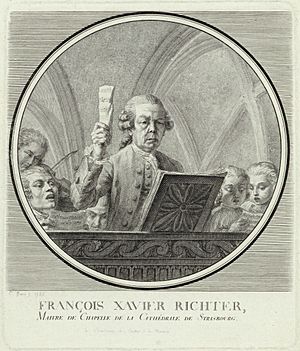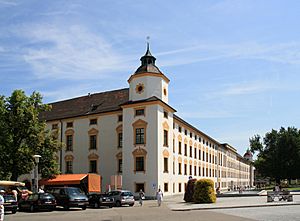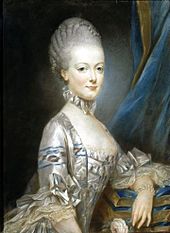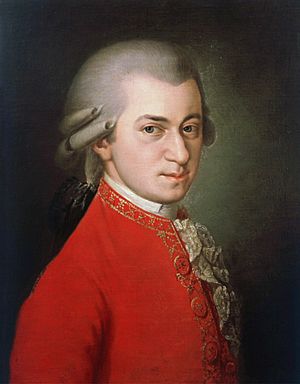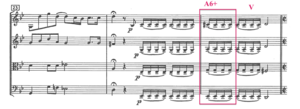Franz Xaver Richter facts for kids
Franz Xaver Richter (born December 1, 1709 – died September 12, 1789) was a talented musician. He was a singer, violinist, composer, conductor, and music teacher. He was born in what is now the Czech Republic. Richter spent most of his life in Austria, then in Mannheim, Germany, and finally in Strasbourg, France. In Strasbourg, he became the music director for the main cathedral. Later in his life, Joseph Haydn's student, Ignaz Pleyel, worked as his assistant.
Richter was one of the first composers of the "Mannheim school" of music. He was known for his skill in counterpoint, a way of writing music with several independent melodies. He wrote many concertos and church music. Even Wolfgang Amadeus Mozart liked his music. Mozart once called a mass by Richter "charmingly written." Richter was also one of the first conductors to use a rolled-up music sheet to lead the orchestra.
Richter mainly wrote symphonies, concertos for woodwind instruments and trumpet, and church music. His masses were especially praised. His music connects the older style of composers like Johann Sebastian Bach and George Frideric Handel with the newer "1st Viennese school" style. His orchestral works are lively and powerful. Recently, more of his music, especially his symphonies and concertos, are being performed and recorded. He was also friends with famous composers like Haydn and Mozart.
Biography
Early Life and Training (1709–1739)
Franz Xaver Richter was likely born in Holleschau (now Holešov) in Moravia. This area is now part of the Czech Republic. However, his birth record is not in the local church books. Some documents say he was from Bohemia. Others suggest he might have been from Hungary or Graz.
We don't know much about Richter's early years until 1740. But it's clear he received excellent training in counterpoint. He probably learned using a famous music book called Gradus ad Parnassum by Johann Fux. Richter might even have been Fux's student in Vienna. His strong skill in church music, seen in his religious works and even his symphonies, shows his roots in the older Baroque music style of Austria and southern Germany.
Working in Kempten (1740–1747)
On April 2, 1740, Richter got a job in Kempten, Germany. He became the deputy music director (Vize-Kapellmeister) for the Prince-Abbot of Kempten. Kempten was home to a large Benedictine monastery. This monastery would have had a choir and a small orchestra. Richter stayed in Kempten for six years. It's thought that he, with his great talent, didn't want to spend his whole life in such a small town.
In February 1743, Richter married Maria Anna Josepha Moz. She was likely from Kempten. In 1744, twelve of Richter's symphonies were published in Paris. Richter probably left Kempten before the Prince-Abbot died in December 1747.
Mannheim Years (1747–1768)
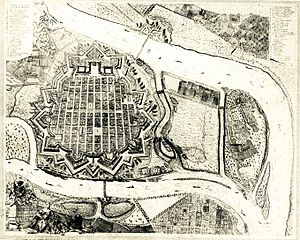
Richter probably didn't like Kempten very much. In 1747, he joined the court musicians in Mannheim. This was a big change. He wasn't a music director there. Instead, he was a bass singer. The Mannheim court had a large music group, with over 70 singers and orchestra members. Richter preferred being one of many in Mannheim over being a deputy director in a small town.
Richter's music style was seen as a bit old-fashioned in Mannheim. He was given the title Cammercompositeur (chamber composer) in 1768. This seems to have been more of an honorary title. He was more successful as a composer of religious music and as a music teacher. In 1748, he wrote an oratorio for Good Friday called La deposizione dalla croce.
Richter was also a respected teacher. Between 1761 and 1767, he wrote a book about composing music. It was based on Fux's famous Gradus ad Parnassum. This was the only book of its kind written by someone from the Mannheim School. Some of his notable students included Joseph Martin Kraus and Carl Stamitz.
After 1768, Richter's name no longer appeared on the court singer lists. During his time in Mannheim, he traveled to other courts and countries. His music was popular with publishers in France, the Netherlands, and England. Richter's music didn't quite fit the Mannheim style. His colleagues liked lively, energetic music. Richter, however, wrote music that reminded people of Handel and his teacher Fux. So, when a job opened at Strasbourg's cathedral in 1769, Richter applied right away.
Strasbourg Cathedral (1769–1789)
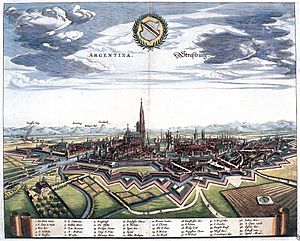
In April 1769, Richter became the music director (Kapellmeister) at Strasbourg Cathedral. Here, he focused more on sacred (religious) music. He was known as a leading composer of church music. Johann Nikolaus Forkel, a famous music historian, wrote about Richter in 1782: "Is a very good contrapuntist and church composer."
In Strasbourg, Richter also directed concerts at the Episcopal court. This court was located in the Palais Rohan. He was also in charge of the town concerts for a while. Most of Richter's sacred music was written during his years in Strasbourg. He continued composing until his last year. In his final years, Joseph Haydn's favorite student, Ignaz Pleyel, helped him at the cathedral. Pleyel took over the job after Richter died.
In 1787, Richter visited Munich. There, he met Mozart's father, Leopold Mozart, one last time. He also saw many of his old friends from the Mannheim court orchestra. They had moved to Munich when the court moved there.
Richter died in Strasbourg at age 79, in the same year the French Revolution began.
Richter Meets Marie Antoinette (1770)
In 1770, Marie Antoinette, who would later become the Queen of France, passed through Strasbourg. She was on her way from Vienna to Paris. She stayed at the Episcopal Palace, the Palais Rohan. Richter composed a special piece of music, a motet called Audin pulsantur, for this event. Richter likely directed the church music when Marie Antoinette attended mass the next day.
The city of Strasbourg was decorated beautifully to welcome her. Young children dressed as guards lined her path. Twenty-four young girls from important families threw flowers before her. Eighteen shepherds and shepherdesses also gave her baskets of flowers. The next day, Marie Antoinette visited the cathedral. The bishop's nephew, Louis de Rohan, greeted her. He would later be involved in a scandal that affected Marie Antoinette.
Richter Meets Mozart (1778)
Both Wolfgang Amadeus Mozart and his father Leopold Mozart knew Richter. Mozart might have met him as a boy in 1763. This was during the Mozart family's "Grand Tour" when they visited Schwetzingen.
Mozart met Richter again in 1778. Mozart was traveling back to Salzburg from Paris. He had hoped to find a permanent job in Mannheim or Paris, but it didn't work out. Mozart wrote about meeting Richter: "You cannot think how much I am esteemed and beloved here. People say that I am disinterested as well as steady and polite, and praise my manners. Everyone knows me. As soon as they heard my name, the two Herrn Silbermann and Herr Hepp (organist) came to call on me, and also Kapellmeister Richter. He has now restricted himself very much; instead of forty bottles of wine a day, he only drinks twenty! ... Last Sunday I heard a new mass of Herr Richter's, which is charmingly written."
Mozart didn't praise music lightly. So, calling Richter's mass "charmingly written" was a very high compliment from him.
Richter's Early Symphonies
One of Franz Xaver Richter's symphonies is the Adagio and Fugue in G minor for Strings (1760). This piece shows his "learned style" in orchestral music. His experience in churches helped him create complex musical lines. The first part of this symphony, called Adagio and Fugue, starts in G minor. It is different from the later symphonies by Haydn and Mozart.
The beginning of Richter's symphony is not as easy to remember as themes by Mozart or Haydn. It uses many repeating musical patterns. The music moves through different keys. For example, it reaches B-flat major for the first time after a certain point. Later, it goes to C major. The first movement has two main parts: an Adagio (like an introduction) and a fugue. This is very different from the "sonata-allegro form" that Mozart and Haydn used.
Music experts say that Richter's music changed over time. It went from an older Baroque sound to a style closer to the Classical period. He used older techniques like fugues and Baroque sequences. He also used minor keys often. This symphony, the Adagio and Fugue in G minor, shows how he combined these older styles with newer ideas.
Works (overview)
Orchestral Music
- Symphonies (about 80 still exist)
- Grandes Symphonies 1-6 (published in Paris 1744)
- Grandes Symphonies 7–12 (published in Paris 1744)
- Several concertos for flute, oboe, and trumpet with orchestra
Sacred Music (Religious Music)
- Kempten Te Deum for solo singers, choir, and orchestra (1745)
- 39 Masses
- La Deposizione della Croce (Oratorio, 1748)
- Many motets and psalms
Chamber Music
- Sonate da camera Op. 2 Nr. 1-6 (sonatas for harpsichord, flute, and cello)
- Seven String Quartets, Op. 5 Nr. 1, 2, 3, 4, 5, 5b, 6 (1757)
Discography (selection)
- Grandes Symphonies (1744), Nos. 1–6 (Set 1) (Helsinki Baroque, Hakkinen) NAXOS 8.557818
- Grandes Symphonies (1744), Nos. 7–12 (Set 2) (Helsinki Baroque, Hakkinen) NAXOS 8.570597
- Sonate da camera (1764): Nos. 1–3 (Fred, Peltoniemi, Hakkinen) NAXOS 8.572029
- Symphonies (London Mozart Players, Bamert) Chandos
- Seven String Quartets, Op. 5 (1757) (casalQuartet) Solo Musica SM 184 (2014)
See also
 In Spanish: František Xaver Richter para niños
In Spanish: František Xaver Richter para niños


